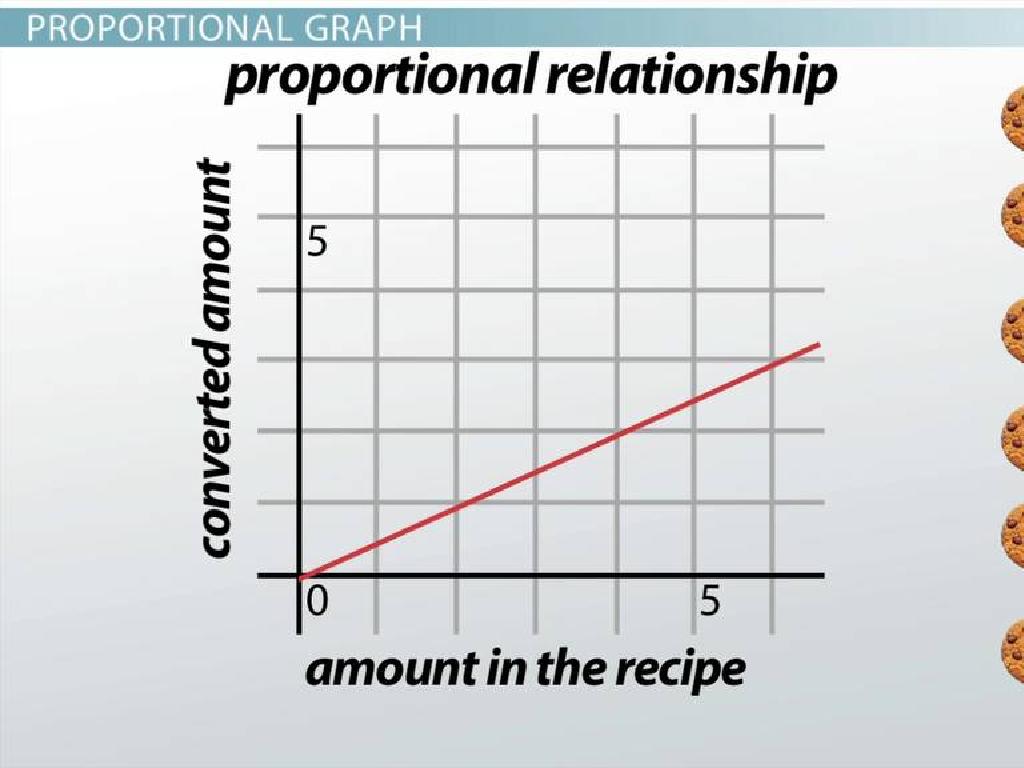Decimal Numbers Review
Subject: Math
Grade: Seventh grade
Topic: Decimals
Please LOG IN to download the presentation. Access is available to registered users only.
View More Content
Welcome to Decimals!
– Exploring the decimal system
– Decimals represent fractions of a whole
– Reviewing decimal place values
– Importance of tenths, hundredths, thousandths
– Decimals in daily life
– Money, measurements, and statistics
– Practice with real-world examples
– Calculate change, measure ingredients, interpret data
|
This slide introduces students to the concept of decimals and their importance in various aspects of daily life. Begin by explaining that decimals are another way to represent fractions and are based on the number 10. Emphasize the significance of understanding place values such as tenths, hundredths, and thousandths, as this is crucial for performing operations with decimals. Provide examples of how decimals are used in everyday situations, such as dealing with money, measuring ingredients for recipes, or understanding statistics in sports. Encourage students to think of additional examples and to practice these concepts through real-world applications. This will help solidify their understanding and show the relevance of decimals beyond the classroom.
Understanding Decimals
– Define a decimal number
– A number with a fraction part separated by a decimal point
– Significance of the decimal point
– Indicates the start of the fractional part of a number
– Whole numbers vs. decimals
– Whole numbers are to the left, decimals are to the right of the point
|
This slide introduces the concept of decimal numbers, which are essential in understanding our number system. A decimal number consists of a whole number part and a fractional part, separated by a decimal point. The decimal point plays a crucial role as it delineates the boundary between the whole number and the fractional parts. It’s important to distinguish between whole numbers, which are complete units, and decimal numbers, which include fractions of a whole. Emphasize that decimals allow for greater precision in measurement and calculation. Provide examples of decimals in everyday use, such as money, measurements, and statistics, to illustrate their practical importance.
Understanding Decimal Place Values
– Review place values post-decimal
– Each place value to the right of the decimal represents a division by 10
– Grasp tenths, hundredths, thousandths
– Tenths: 0.1, Hundredths: 0.01, Thousandths: 0.001
– Compare digit values in places
– A digit in the tenths place is 10 times the value of the same digit in the hundredths place
– Decimal place value importance
|
This slide aims to reinforce the concept of decimal place values, which is crucial for understanding and working with decimals. Begin by reviewing the place values immediately following the decimal point and explain how each successive place value represents a further division by 10. Use visual aids or a place value chart to illustrate tenths, hundredths, and thousandths. Highlight the significance of a digit’s position by comparing values in different places, such as how 0.3 (three-tenths) is greater than 0.03 (three-hundredths). Emphasize the importance of these concepts in real-world applications like measuring distances, weights, and financial transactions. Encourage students to practice by identifying place values in various decimal numbers and comparing the values of digits in different decimal places.
Adding and Subtracting Decimals
– Align decimal points vertically
– Ensure decimals are in a column for clarity
– Follow step-by-step addition
– Add numbers as with whole numbers, column by column
– Follow step-by-step subtraction
– Subtract like whole numbers, borrow if needed
– Solve practice problems together
– Use example problems to apply what we’ve learned
|
This slide focuses on the fundamental skills needed to add and subtract decimal numbers. Emphasize the importance of aligning decimal points before performing the operations, as this is crucial for maintaining place value. Walk through the addition and subtraction processes step by step, ensuring students understand how to handle each column, especially when borrowing is required in subtraction. Engage the class with practice problems, encouraging them to solve them on the board or in their notebooks, fostering a collaborative learning environment. Provide immediate feedback and support to solidify their understanding.
Multiplying Decimals
– Steps to multiply decimals
– Align numbers by place value, ignore the decimal, multiply as whole numbers.
– Determining decimal placement
– Count total decimal places in factors, place decimal in product accordingly.
– Work through example problems
– Example: 0.5 x 0.2 = 0.10 (1 decimal place in each factor, 2 in the product).
– Practice with class exercises
|
This slide introduces the process of multiplying decimal numbers, a key concept in understanding and working with decimals. Start by explaining the multiplication of decimals without considering the decimal point, treating the numbers as whole numbers. Emphasize the importance of aligning the numbers by their place value. After the multiplication, guide students on how to place the decimal point in the product by counting the total number of decimal places in the factors. Use clear examples to illustrate the process, and then provide a set of problems for the class to work on individually or in groups, ensuring they apply the steps correctly and understand the concept thoroughly.
Dividing Decimals
– Divide decimals by whole numbers
– Place the decimal point in the quotient directly above the decimal point in the dividend.
– Learn to move the decimal point
– When dividing, if the divisor is not a whole number, move the decimal point to the right to make it whole and do the same in the dividend.
– Work on practice problems
– Solve problems like 12.3 ÷ 3 or 0.56 ÷ 7 to practice.
– Check understanding with examples
|
This slide introduces the concept of dividing decimals by whole numbers. Start by explaining the process step by step, ensuring students understand where to place the decimal in their answer. Emphasize the importance of aligning decimal points. Moving the decimal point is a critical skill; demonstrate this by converting a decimal divisor into a whole number and adjusting the dividend accordingly. Provide a set of practice problems for students to work through, and use examples to check for understanding. Encourage students to explain their reasoning as they solve each problem to reinforce their learning.
Decimal Word Problems
– Apply decimal operations in problems
– Use addition, subtraction, multiplication, division with decimals
– Interpret word problems carefully
– Understand the problem: What is being asked?
– Group activity: collaborative problem-solving
– Work together to find solutions to assigned problems
– Explain your reasoning behind solutions
– Share your thought process with the group
|
This slide is aimed at reinforcing students’ understanding of decimal operations through practical application in word problems. Encourage students to read each problem thoroughly and identify key information before attempting to solve it. Emphasize the importance of understanding the context of the problem to apply the correct operation. The group activity is designed to foster collaborative learning and critical thinking. Each group will solve a set of problems and then explain their reasoning to the class, promoting communication skills and deeper comprehension of the material. Provide guidance on how to break down a problem into smaller, manageable steps and ensure that students are comfortable with decimal operations. Offer several example problems and solutions to demonstrate the process.
Class Activity: Decimal Scavenger Hunt
– Search for decimals in the classroom
– Pair up for the scavenger worksheet
– Record your decimal discoveries
– Note where you found each decimal and its use
– Discuss findings with the class
|
This interactive activity is designed to help students recognize the prevalence and practicality of decimals in everyday environments. Students should work in pairs to foster collaboration. Provide a worksheet with specific items to look for, ensuring they include decimals (e.g., measurements on a ruler, quantities on containers, or numbers in a textbook). After the hunt, ask students to share where they found decimals and discuss their significance. This will reinforce their understanding of decimals and their applications. For the teacher: Prepare a diverse list of items for the scavenger hunt that requires students to search thoroughly. Consider having different worksheets for each pair to encourage a wide range of findings.
Decimals: Wrapping Up & Homework
– Recap today’s decimal concepts
– Importance of decimal mastery
Decimals are crucial in math and everyday life.
– Homework: Decimal operations worksheet
Complete the worksheet to reinforce today’s lesson.
– Practice makes perfect
Consistent practice is key to becoming proficient.
|
As we conclude today’s lesson on decimals, it’s important to review the key concepts covered, such as place value, adding, subtracting, multiplying, and dividing decimals. Emphasize to students the importance of mastering these operations as they are widely used in real-world applications like financial transactions, measurements, and data analysis. For homework, students are assigned a practice worksheet that includes a variety of decimal operations to ensure they apply what they’ve learned. Encourage them to attempt all problems and remind them that consistent practice is essential for mastery. The next class will begin with a discussion of any challenges faced in the homework.





/eighth_grade_research_skills.jpg)
